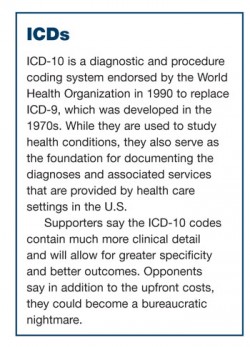ACA Impact on Comp
Key Reasons to Convert to ICD-10 Codes

Starting Oct. 1, the International Classification of Diseases, 10th Revision officially replaces the ninth revision for all entities covered by the Health Insurance Portability and Accountability Act (see box). Since workers’ comp is not a covered entity, practitioners are not required to make the conversion and would continue using ICD-9.
But chaos, costs, and catastrophe may await those who ignore the change, according to some experts. Those that do not switch to ICD-10 will be using a different coding system than many of the providers and vendors with whom they collaborate.
Reasons to Convert
“The greatest impact that needs to be considered and addressed is the negative impact to the injured workers and the potential for reduced provider participation to care for these injured workers,” said Sherry Wilson, a member of the Workgroup for Electronic Data Interchange and the executive vice president/chief compliance officer of Jopari Solutions. “This could result in additional burdens to the already injured worker that may include longer drives to see a physician, longer wait time for authorizations, and longer lost time from work.”
The Workgroup for Electronic Data Interchange is named as an advisor to the Department of Health and Human Services under the HIPAA regulation. Wilson’s comments during a recent hearing before an HHS panel related what many observers fear will happen to workers’ comp payers that do not convert to ICD-10 diagnostic codes before the change takes effect.
 “I think what’s going to happen is it will create confusion; it will slow things down,” said Jennifer Wolf-Horejsh, executive director of the International Association of Industrial Accident Boards and Commissions. “It will create a backlog because you are going to require providers to be coding in two systems. There’s not an easy crosswalk. It will become cumbersome to maintain.”
“I think what’s going to happen is it will create confusion; it will slow things down,” said Jennifer Wolf-Horejsh, executive director of the International Association of Industrial Accident Boards and Commissions. “It will create a backlog because you are going to require providers to be coding in two systems. There’s not an easy crosswalk. It will become cumbersome to maintain.”
The IAIABC has been instrumental in working with states to ensure jurisdictional statutes and regulations don’t impede the process. While some jurisdictions do not include ICD codes in their rules or data requirements, many do. To date, at least 20 states have adopted the required changes to enable the use of ICD-10 codes by Oct. 1.
Workers’ comp payers that don’t convert to ICD-10 may find pushback from their providers. “Why would they want to give you both codes,” said John Sarich, vice president of strategy at VUE Software. “Your problem is not their problem. They have to comply with the law.”
Resistance to Change
Among the reasons for not planning to convert are the effort and money that is required to change systems. Estimates range from tens of thousands to millions of dollars.
“It means very big software changes because you’re going from a five-digit diagnostic code to a seven-digit code that is alpha numeric,” Wolf-Horejsh said. “Then there is a lot of training and business process engineering. It’s not as simple as a switch of a code. It’s just a very different structure.”
But maintaining two systems won’t be easy for payers either because they will need to train and retain staff fluent in two medical coding languages and spend time translating and working on a now-dead language.
Sarich says workers’ comp payers who resist the conversion are avoiding the inevitable. He likens it to another law that did not require participation from the workers’ comp industry.
“I remember when HIPAA went into effect and insurance companies said ‘I don’t have to worry about HIPAA,’” he said. “I said, ‘you’d be smart to worry.’ That was a tough sell to get P&C companies to understand.”
Hearing the same argument about ICD-10, Sarich is telling carriers that they don’t operate in a vacuum. “I say, ‘you’re a payer, and doctors are not going to submit codes with ICD-9 and you are not going to have a clue and your systems won’t hold it. They are legacy systems,’” he said. “Going to 72,000 codes — you aren’t going to do that just off the back of a napkin.”
Benefits to Workers’ Comp
The increase in the number of codes from ICD-9 to ICD-10 — from about 14,000 to 70,000 or more — is among the biggest changes. Included in ICD-10, for example, is the side of the body on which the injury occurred.
“It can give you more specific data,” said Wolf-Horejsh. “That will empower you to do better analyses and better understand the health outcomes.”
Supporters also say it can help practitioners do a deep dive into their data. Sarich said he was working with a client several years ago who wanted to know how to find out more about what goes on during a claim.
“At any point in time in our active files we have 10 people who lost their left arm in an industrial accident. All 10 have different outcomes. Is it because of the physician, the lawyer, the hospital? Why is there such a range of difference in cost?” he said. “This is what ICD-10 is going to get you. To see that granular data and understand the best providers you can be working with and it very well may be it will help comp carriers restructure their businesses and work with providers with better outcomes for certain kinds of accidents. In the long term, that will save money and reduce costs. But getting there is going to be the challenge.”










